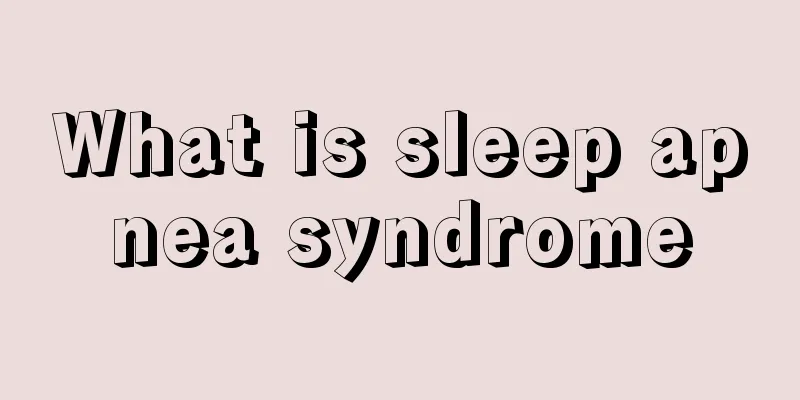What is sleep apnea syndrome

|
If it is said that someone stops breathing during sleep, would you feel scared or even think it is an exaggeration? In fact, there is a disease called sleep apnea syndrome, in which patients will experience more than 30 moments of respiratory arrest during sleep, and as the condition becomes more serious, this respiratory arrest will become more severe. 1. What is sleep apnea syndrome? A clinical syndrome of chronic hypoxemia and hypercapnia is caused by more than 30 apneas during 7 consecutive hours of sleep, with each airflow cessation lasting more than 10 seconds (including 10 seconds), or an average of more than 5 hypoventilations per hour (respiratory disorder index). It can be divided into central type, obstructive type and mixed type. People at high risk of sleep apnea syndrome include those who are obese, have narrow airway structure, have relaxed muscles due to old age, have enlarged tonsils, have a short jaw, or have airway edema caused by long-term smoking. These patients will have a blocked throat when they sleep and cannot breathe air. Classification of sleep apnea syndrome 1. Obstructive sleep apnea (OSA): The relaxation of soft tissue near the throat causes upper airway obstruction, and the narrowing of the airway leads to apnea during sleep. 2. Central sleep apnea: The respiratory center has been damaged by stroke, trauma, etc. and is obstructed, unable to transmit breathing commands normally, leading to sleep apnea. 3. Mixed Apnea: Mixed obstructive sleep apnea and central nervous system sleep apnea Clinical manifestations of sleep apnea syndrome 1. Shallow sleep Sleep apnea makes sleep very shallow and fragmented. Patients cannot enjoy quality sleep. Even if they sleep for ten hours, they cannot get enough rest, which leads to daytime lack of energy and other serious adverse consequences. There will be a feeling of suffocation and accompanied by body movements, which may suddenly wake the person up, and after taking a few breaths, the person will fall asleep again. Frequent tossing and turning or limb movement during sleep may kick and injure the person sleeping with the bed; sometimes he suddenly sits up, mumbling to himself, and then suddenly falls asleep again with a stiff neck. 2. Daytime fatigue Feelings of daytime fatigue, sleepiness, lack of energy, morning headaches, dullness, and decreased memory, concentration, judgment, and alertness. Depression, anxiety, irritability, dry mouth, loss of libido, and high blood pressure may occur. 4. Common Populations of Sleep Apnea Syndrome It is more common in people aged 40-60 years old, and more common in overweight middle-aged and elderly men. The clinical features are composed of alternating loud snoring, brief wheezing and apnea lasting more than 10 seconds. Apnea is characterized by cessation of airflow from the mouth and nose, but chest and abdominal breathing still exists. |
<<: What is the best way to wash your face? Five anti-aging face washing methods
>>: What causes cracked feet and how to treat and maintain them
Recommend
Common knowledge about medication for pain in patients with lymphoma
Lymphoma patients in the late stage will suffer f...
Can the second molar be extracted?
The second molar is the molar in the upper jaw. I...
There is often eye mucus in the corners of the eyes
When everyone wakes up in the morning and looks i...
The correct way to use the disinfection cabinet
When using a disinfection cabinet, you must pay a...
There are five main symptoms of hidradenitis
Hidradenitis generally occurs in the subcutaneous...
Which one is better for anti-wrinkle effect, loofah or ginkgo?
When people reach a certain age, their skin will ...
Tips for itchy nose
Itching inside the nose is very common in life. W...
What are the dangers of scrotitis?
Scrotitis is not unfamiliar to male friends, beca...
How to remove bikini hair
In the hot summer or when we go to the beach, gir...
Extrapyramidal symptoms
Many people with mental illnesses need to take or...
Measures to prevent testicular cancer in life
Testicular cancer occurs in testicular tissue and...
How much do you know about the benefits of applying cooling oil to various parts of the body
Many people born in the 1980s may still vaguely r...
What are the symptoms of liver cancer? Three symptoms indicate that you have liver cancer
1. Weight loss and fatigue. Patients with liver c...
Can hair follicles regenerate?
Many people mistakenly believe that hair follicle...
Can late stage kidney cancer be contagious through saliva?
The question of whether cancer is contagious may ...









